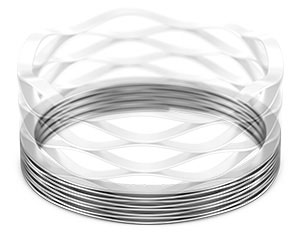Would a Standard Wave Spring Made in a Special Material Maintain the Same Spring Rate and Performance?


There are many factors to consider when designing a product. Will the product be exposed to high temperatures or high humidity? Perhaps it will frequently come into contact with certain chemicals or harsh environments. Not to mention, how will using a specialty alloy affect the performance of a product?
At Smalley, our engineers know the demands called upon by different applications. That is why we offer our rings and springs in various materials to find the right fit for every assembly!
As the premier source for retaining rings and wave springs, we have hundreds of standard products, in-stock and ready to be shipped. While carbon and stainless steel are our most commonly used alloys, we have over 40 different materials available for custom products. Our edge-winding manufacturing process makes creating customs a pain-free process! By eliminating the need for expensive tooling, China Wave Spring has simplified ordering custom parts far more than other manufacturers.
When creating a standard part in a non-standard alloy, one commonly asked question is if the listed performance specifications will remain the same. This is an understandable concern, seeing as different alloys have different properties.
The short answer is no; the specifications listed for a standard part will not remain the same when a custom alloy is used instead. For example, Hastelloy-C276 has a different tensile strength and modulus of elasticity than carbon, affecting the spring rate of the wave spring, among other changes. To keep the same specifications with a new material, there will likely be some adjustments.
If we take a standard and change the material, we typically keep the load at the work height the same since those dimensions are the most critical for a standard. The spring rate difference would show up in a slightly different reference-free height.
If we wanted to keep the free height the same as the standard, the working height would differ for the same load. One of the more important things to consider is avoiding the overstressing of the spring within the working range. If you take it past the working height, it will not be guaranteed to perform as intended.
Let’s take a CS043-M1, for example. It has a load of 8 lbs at a work height of 0.082”. It features a 3-turn design with 2.5 waves per turn. If we engineer this product in a different alloy, but would like to maintain the work height, we would have to modify the wire thickness, number of waves, number of turns, or other factors. In theory, we are taking a standard part with a pre-determined load, but modifying it to the extent that it may no longer resemble the original part. We will then have a completely customized product, and that’s quite all right!
Easy Customization
China Wave Spring specializes in custom parts because we know that every application is unique, and it can be difficult to find a standard part to match your requirements.
For the production spring, copying a standard exactly doesn't make it any less expensive. It's usually better to tell us the application requirements, and we can build the product based on that. The key advantage of copying a standard parts design is that the standard part can be used to perform a quick fit and function test in the application.
If you would like more information from our engineering team regarding your custom product, we encourage you to complete our Product Application Checklist. This will help our engineers understand your requirements and offer a solution to meet your needs!
As for any technical product questions, China Wave Spring engineers are here to assist. Contact us now to get started, or submit your own Ask the Expert question!



Connect With Us